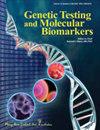中国西南部云南省大姚县鳄鱼石污染区胸膜间皮瘤与致癌型 Simian Virus 40 的关联研究
IF 1.1
4区 生物学
Q4 GENETICS & HEREDITY
引用次数: 0
摘要
背景:在中国西南部云南省楚雄彝族自治州大姚县,5%的地表散布着蓝石棉,是胸膜间皮瘤(PMe)的高发区。Simian virus 40(SV40)是一种小型环状双链 DNA 多瘤病毒,可引起各种人类和动物组织正常细胞的恶性转化,并促进肿瘤生长。本研究探讨了致癌病毒 SV40 是否与中国西南部云南省大姚县青石棉污染区 PMe 的发生有关。研究方法收集51例PMe患者(其中40例有石棉接触史)的肿瘤组织和12例非PMe患者(包括肺黄斑病变和肺结核等疾病)的胸膜组织。使用三对低污染风险引物(SVINT、SVfor2 和 SVTA1)通过聚合酶链反应(PCR)检测 SV40 大 T 抗原(T-Ag)的基因片段。通过 Western 印迹和 SV40 相关抗体(PAb 101 和 PAb 416)免疫组化染色检测 PMe 肿瘤组织和 PMe 细胞系中 SV40 T-Ag 的存在。结果PCR、Western 印迹和免疫组化染色结果显示,Met5A 细胞系的 SV40 阳性,含有 SV40 T-Ag 基因和蛋白。相比之下,各种 PMe 细胞系 NCI-H28、NCI-H2052 和 NCI-H2452 的 SV40 阴性。在 12 个非 PMe 组织和 51 个 PMe 组织中,三组低污染风险引物的 PCR 结果均为阴性。免疫组化染色法在 12 个非 PMe 组织和 51 个 PMe 组织中均未检测到 SV40 T-Ag。结论我们的数据表明,云南省青石棉污染区发生的PMe可能与SV40感染无关,青石棉暴露可能是导致PMe的主要原因。临床试验注册号:2020-YXLL20。本文章由计算机程序翻译,如有差异,请以英文原文为准。
Association Study of Pleural Mesothelioma and Oncogenic Simian Virus 40 in the Crocidolite-Contaminated Area of Dayao County, Yunnan Province, Southwest China.
Background: In Dayao County, Chuxiong Yi Autonomous Prefecture, Yunnan Province, Southwest China, 5% of the surface is scattered with blue asbestos, which has a high incidence of pleural mesothelioma (PMe). Simian virus 40 (SV40) is a small circular double-stranded DNA polyomavirus that can cause malignant transformation of normal cells of various human and animal tissue types and promote tumor growth. In this study, we investigate whether oncogenic SV40 is associated with the occurrence of PMe in the crocidolite-contaminated area of Dayao County, Yunnan Province, Southwest China. Methods: Tumor tissues from 51 patients with PMe (40 of whom had a history of asbestos exposure) and pleural tissues from 12 non-PMe patients (including diseases such as pulmonary maculopathy and pulmonary tuberculosis) were collected. Three pairs of low-contamination risk primers (SVINT, SVfor2, and SVTA1) were used to detect the gene fragment of SV40 large T antigen (T-Ag) by polymerase chain reaction (PCR). The presence of SV40 T-Ag in PMe tumor tissues and PMe cell lines was detected by Western blotting and immunohistochemical staining with SV40-related antibodies (PAb 101 and PAb 416). Results: PCR, Western blotting, and immunohistochemical staining results showed that the Met5A cell line was positive for SV40 and contained the SV40 T-Ag gene and protein. In contrast, the various PMe cell lines NCI-H28, NCI-H2052, and NCI-H2452 were negative for SV40. PCR was negative for all three sets of low-contamination risk primers in 12 non-PMe tissues and 51 PMe tissues. SV40 T-Ag was not detected in 12 non-PMe tissues or 51 PMe tissues by immunohistochemical staining. Conclusion: Our data suggest that the occurrence of PMe in the crocidolite-contaminated area of Yunnan Province may not be related to SV40 infection and that crocidolite exposure may be the main cause of PMe. The Clinical Trial Registration number: 2020-YXLL20.
求助全文
通过发布文献求助,成功后即可免费获取论文全文。
去求助
来源期刊
CiteScore
2.50
自引率
7.10%
发文量
63
审稿时长
1 months
期刊介绍:
Genetic Testing and Molecular Biomarkers is the leading peer-reviewed journal covering all aspects of human genetic testing including molecular biomarkers. The Journal provides a forum for the development of new technology; the application of testing to decision making in an increasingly varied set of clinical situations; ethical, legal, social, and economic aspects of genetic testing; and issues concerning effective genetic counseling. This is the definitive resource for researchers, clinicians, and scientists who develop, perform, and interpret genetic tests and their results.
Genetic Testing and Molecular Biomarkers coverage includes:
-Diagnosis across the life span-
Risk assessment-
Carrier detection in individuals, couples, and populations-
Novel methods and new instrumentation for genetic testing-
Results of molecular, biochemical, and cytogenetic testing-
Genetic counseling

 求助内容:
求助内容: 应助结果提醒方式:
应助结果提醒方式:


